
Willem Drost was a Dutch Golden Age painter and printmaker of history paintings and portraits.
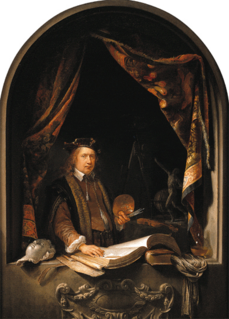
Gerrit Dou, also known as GerardDouw or Dow, was a Dutch Golden Age painter, whose small, highly polished paintings are typical of the Leiden fijnschilders. He specialised in genre scenes and is noted for his trompe-l'œil "niche" paintings and candlelit night-scenes with strong chiaroscuro. He was a student of Rembrandt.

The Herzog Anton Ulrich Museum (HAUM) is an art museum in the German city of Braunschweig, Lower Saxony.

Portrait of Baldassare Castiglione is a c. 1514–1515 oil painting attributed to the Italian High Renaissance painter Raphael. Considered one of the great portraits of the Renaissance, it has an enduring influence. It depicts Raphael's friend, the diplomat and humanist Baldassare Castiglione, who is considered a quintessential example of the High Renaissance gentleman.

Rembrandt Harmenszoon van Rijn was a Dutch draughtsman, painter, and printmaker. An innovative and prolific master in three media, he is generally considered one of the greatest visual artists in the history of art and the most important in Dutch art history. Unlike most Dutch masters of the 17th century, Rembrandt's works depict a wide range of style and subject matter, from portraits and self-portraits to landscapes, genre scenes, allegorical and historical scenes, and biblical and mythological themes as well as animal studies. His contributions to art came in a period of great wealth and cultural achievement that historians call the Dutch Golden Age, when Dutch art, although in many ways antithetical to the Baroque style that dominated Europe, was extremely prolific and innovative and gave rise to important new genres. Like many artists of the Dutch Golden Age, such as Jan Vermeer of Delft, Rembrandt was also an avid art collector and dealer.

Jan Six was an important cultural figure in the Dutch Golden Age.
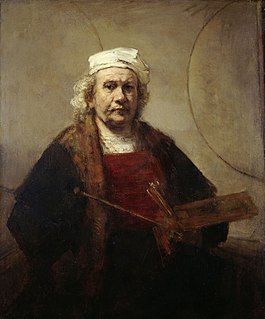
A self-portrait is a representation of an artist that is drawn, painted, photographed, or sculpted by that artist. Although self-portraits have been made since the earliest times, it is not until the Early Renaissance in the mid-15th century that artists can be frequently identified depicting themselves as either the main subject, or as important characters in their work. With better and cheaper mirrors, and the advent of the panel portrait, many painters, sculptors and printmakers tried some form of self-portraiture. Portrait of a Man in a Turban by Jan van Eyck of 1433 may well be the earliest known panel self-portrait. He painted a separate portrait of his wife, and he belonged to the social group that had begun to commission portraits, already more common among wealthy Netherlanders than south of the Alps. The genre is venerable, but not until the Renaissance, with increased wealth and interest in the individual as a subject, did it become truly popular.

The Prodigal Son in the Brothel or The Prodigal Son in the Tavern or Rembrandt and Saskia in the parable of the prodigal son is a painting by the Dutch master Rembrandt. It is housed in the Gemäldegalerie Alte Meister of Dresden, Germany. It is signed "REMBRANDT F.".

Self-Portrait with Beret and Turned-Up Collar is a 1659 oil on canvas painting by the Dutch artist Rembrandt, one of over 40 self-portraits by Rembrandt. It has been noted as a self-portrayal of subtle and somber qualities, a work in which may be seen "the stresses and strains of a life compounded of creative triumphs and personal and financial reverses". Once owned by Andrew W. Mellon, it has been in the National Gallery of Art since 1937.
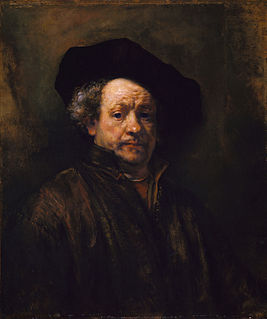
Self-Portrait is a 1660 oil on canvas painting by the Dutch artist Rembrandt, one of over 40 self-portraits by Rembrandt. Painted when the artist was fifty-four, it has been noted as a work in which may be seen "the wrinkled brow and the worried expression the troubled condition of his mind". Part of the Benjamin Altman Collection, it has been in the Metropolitan Museum of Art since 1913.
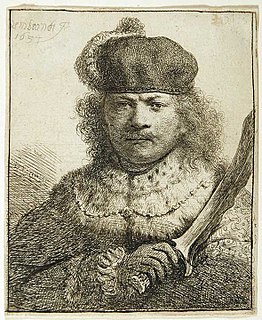
The dozens of self-portraits by Rembrandt were an important part of his oeuvre. Rembrandt created approaching one hundred self-portraits including over forty paintings, thirty-one etchings and about seven drawings; some remain uncertain as to the identity of either the subject or the artist, or the definition of a portrait.
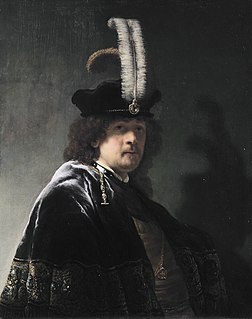
Self-portrait wearing a white feathered bonnet is an oil painting attributed to the Dutch painter Rembrandt. It is signed and dated 1635. It was traditionally regarded as a Rembrandt self-portrait until 1968, when it was rejected on stylistic grounds in the Rembrandt catalogue raisonné by Horst Gerson. In 2013, art historian Ernst van de Wetering re-attributed the painting as an original Rembrandt. It is one of over 40 painted self-portraits by Rembrandt.

This 1629 self-portrait by Dutch painter Rembrandt van Rijn is part of the Clowes Fund Collection of the Indianapolis Museum of Art in Indianapolis, Indiana. It is among the earliest of over 40 self-portraits by Rembrandt, which he produced over the course of four decades.

A Polish Nobleman is a 1637 painting by Rembrandt depicting a man in a costume of Polish szlachta (nobility). The identity of the subject of the painting is unclear, and has given rise to several different interpretations. The view that the figure's dress is clearly Polish is not universally held and it may have been a self-portrait.
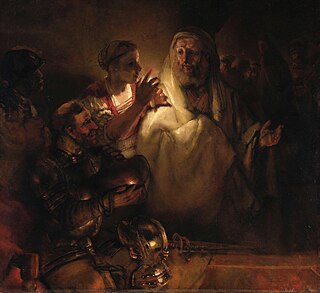
The Denial of Peter is a 1660 painting by Rembrandt, now in the Rijksmuseum in Amsterdam. It depicts the denial of Peter, an event in the Passion of Jesus.

Self-Portrait at the Age of 34 is a self-portrait by Rembrandt, dating to 1640 and now in the National Gallery in London. The painting is one of many self-portraits by Rembrandt, in both painting and etching, to show the artist in a fancy costume from the previous century. In this case specific influences in the pose have long been recognised from Raphael's Portrait of Baldassare Castiglione and Titian's A Man with a Quilted Sleeve in the National Gallery. Rembrandt saw both of these in Amsterdam, in his day the centre of Europe's art trade, and made a sketch of the Raphael, with its price.

'Tronie' of a Young Man with Gorget and Beret, formerly known as Self-portrait as a young man is a tronie portrait of a young man that was traditionally regarded as one of over 40 painted self-portraits by Rembrandt. It is now in the Galleria degli Uffizi in Florence, where the most recent restoration by Daniele Rossi revealed a signature previously hidden under old varnish.

Portrait of Jan Six is a 1654 painting by the Dutch painter Rembrandt van Rijn. Having been handed down many generations, via the direct descendants of the portrait's subject, Jan Six, the work remains in the Six Collection in Amsterdam.
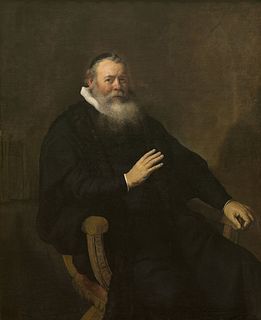
The Preacher Eleazar Swalmius is a 1637 oil on canvas painting by the Dutch artist Rembrandt. It is currently owned by the Royal Museum of Fine Arts in Antwerp. The painting has been certified a real Rembrandt. The painting was listed in 1727 in the catalog of the Duke of Orléans collection, as a portrait of an Amsterdam mayor by Rembrandt. It remained in the noble family's possession until 1792, when Duke Louis-Philippe-Joseph sold the entire collection to finance his political career and pay off debts. The painting passed through several English collections into the hands of the Bourgeois brothers, art dealers from Cologne, who sold the painting as an original Rembrandt to the museum in 1886. The painting was stored away for a long time due to doubts cast over its authenticity.

Rembrandt Laughing is a c. 1628 oil on copper painting by the Dutch painter Rembrandt van Rijn. It is an elaborate study of a laughing face, a tronie, and, since it represents the painter himself, one of over 40 self-portraits by Rembrandt, probably the earliest elaborate one. The painting, which was only recently discovered, is now in the J. Paul Getty Museum, California.




















